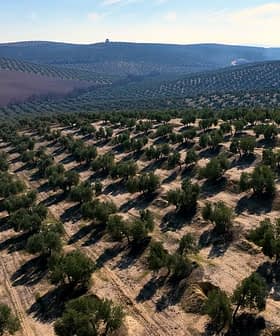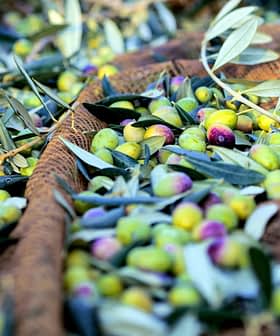 9.6K reads
9.6K readsWorld
Global Olive Oil Production Predicted to Rebound

Global olive oil production is expected to rebound in the upcoming 2023/24 crop year, with the USDA forecasting a 24-percent increase to reach 3.20 million tons, largely due to a significant rebound in the European Union. Additionally, the USDA anticipates that global olive oil consumption will also rebound, with exports expected to grow by 7 percent, led by the E.U., while U.S. imports are forecasted to stay unchanged at 400,000 tons.
According to preliminary estimates from the United States Department of Agriculture, global olive oil production is expected to rebound in the upcoming 2023/24 crop year.
USDA economists forecast production to reach 3.20 million tons in 2023/24, a 24-percent increase compared to last year’s historically poor harvest and just about level with the five-year average of 3.14 million tons.
According to the USDA, a significant rebound in the European Union, the world’s largest olive oil-producing entity, will be largely responsible for rising global yields.
See Also:2023 Harvest UpdatesUSDA economists estimate that the E.U. will produce 2.03 million tons in 2023/24, up from 1.50 million tons in 2022/23 and slightly exceeding the five-year average of 2.00 million tons.
While the anticipated recovery will depend heavily on flowering conditions and precipitation levels in the spring and autumn, rising production in the bloc will likely be fueled by many groves entering an ‘on-year’ in the olive trees’ natural alternate bearing cycle and new plantations entering production.
USDA economists do not publish country-specific data for the E.U. forecast.
Production is also predicted to rebound in Tunisia, rising to an estimated 250,000 tons in 2023/24 from 180,000 tons in 2022/23. The estimated harvest also would be almost 10 percent above the five-year average of 228,000 tons.
The USDA said expectations of rising production in the North African country were attributed to many producers entering an ‘on-year’ and industry sources.
On and off years
In the context of olive oil production, the term “on year” refers to a year in which olive trees produce a higher yield of olives. Olive trees have a natural cycle of alternating high and low production years, known as “on years” and “off years,” respectively. During an on year, the olive trees bear a greater quantity of fruit, resulting in increased olive oil production. This is influenced by various factors, including weather conditions, such as rainfall and temperature, as well as the tree’s age and overall health. Conversely, an off year, also known as a “light year” or “low production year,” is characterized by a reduced yield of olives. This can occur due to factors like stress from the previous on year, unfavorable weather conditions, or natural fluctuations in the tree’s productivity. Olive oil producers often monitor these cycles to anticipate and plan for variations in production. On years are generally preferred as they provide higher quantities of olives for harvesting and processing, leading to increased olive oil output.
While production is expected to rise in the E.U. and Tunisia, the USDA forecasts that the yield will fall to 280,000 tons in Turkey in 2023/24, down from the record-high 421,000 tons of last year but still nearly 14 percent above the five-year average of 246,400 tons.
The USDA expects production to fall in the coming crop year as many producers enter an ‘off-year,’ but projects that production will rise in the long term due to continued government efforts to plant more trees and promote more efficient agricultural practices, including mechanized harvests and drip irrigation.
Country/Region | 2023/24 est (tons) | 2022/23 (tons) | 5‑year avg (tons) |
|---|---|---|---|
European Union | 2,030,000 | 1,504,500 | 2,000,000 |
Tunisia | 250,000 | 180,000 | 228,000 |
Turkey | 280,000 | 380,000 | 246,400 |
World | 3,200,000 | 2,729,500 | 3,140,000 |
“It is quite the challenge to prepare a forecast for olive oil at this point in time, especially given the nature of the crop,” USDA economist Gretchen Kuck told Olive Oil Times.
“We use a combination of market intelligence, cyclical and historical trend data and assumptions about the weather to come to our production forecast for olive oil,” she added. “As the marketing year progresses, we will continue to use trade data, market news and official statistics to calibrate our numbers.”
Along with improved production, the USDA forecasts that global olive oil consumption will also rebound to 2.9 million tons as “low carryin from the current year limits total supplies in 2023/24.”
However, the department’s economists anticipate that consumption will recover more slowly in price-sensitive countries in the Middle East and North Africa, which continue to grapple with high food inflation and more profitable export prices.
The USDA expects global exports to grow by 7 percent due to the production rebound, and olive oil stocks will also recover from last year’s low levels.
The E.U. is expected to lead the way, with exports forecast to rise to 750,000 tons, up from 588,500 tons in 2022/23.
Meanwhile, exports in Turkey are expected to fall from their record-high levels of 2022/23 to 160,000 tons in 2023/24. Still, Turkish exports are expected to remain well above the five-year average due to the upward trend in production compared to stable consumption.
The USDA also expects U.S. imports to stay unchanged at 400,000 tons, with the U.S. remaining the world’s largest importer, capturing about one-third of the global olive oil trade.
“Our consumption and trade forecasts for vegetable oils look at total supplies, substitution options, pricing and consumer preference for the entire world, region and each individual country,” Kuck said.










